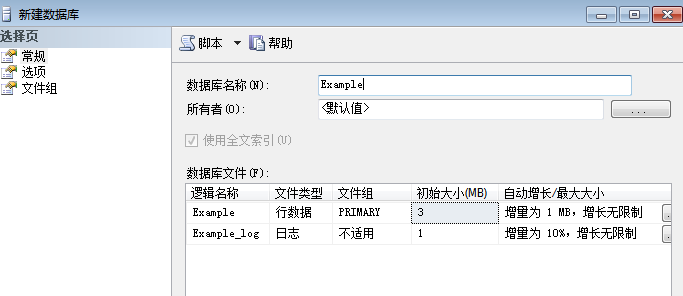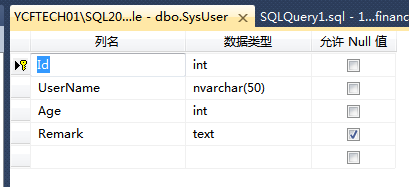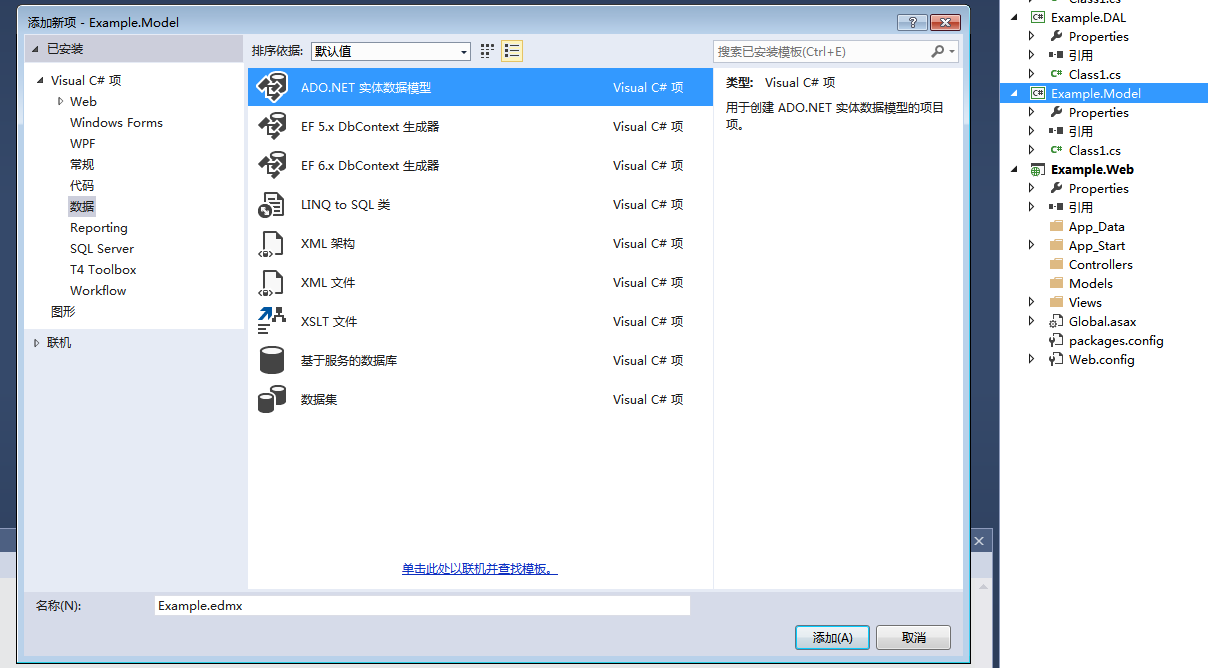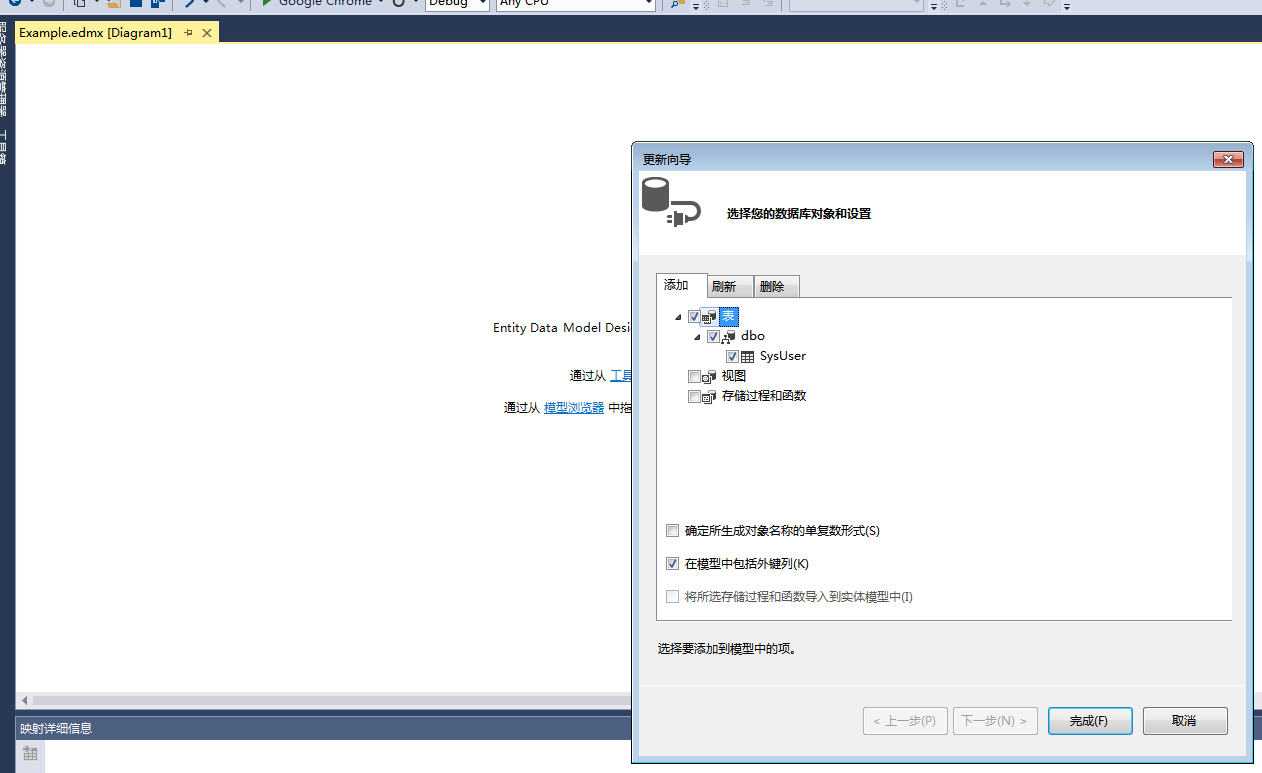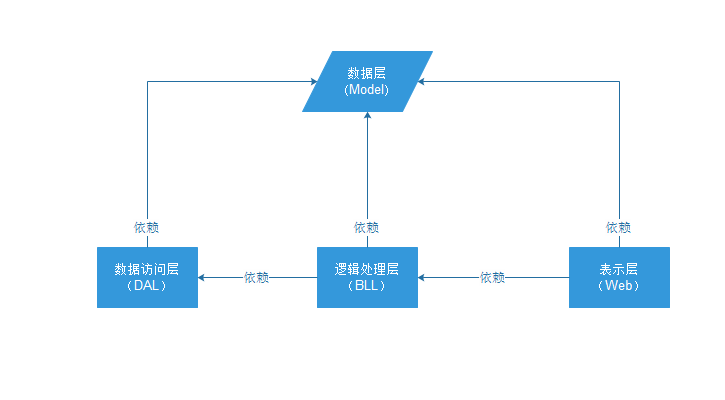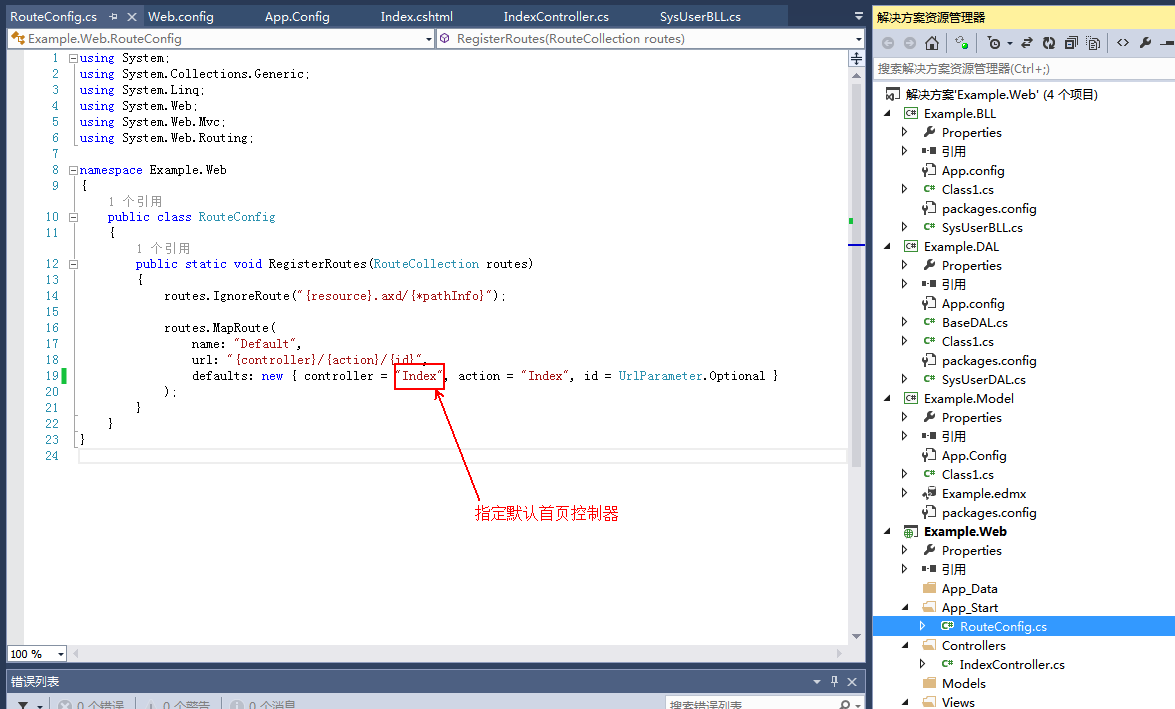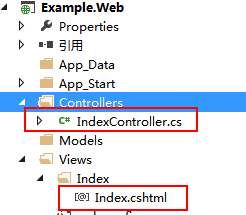http://blog.csdn.net/pukuimin1226/article/details/52313656
版权声明:作者:真爱无限 出处:http://blog.csdn.net/pukuimin1226 本文为博主原创文章版权归作者所有,欢迎转载,但未经作者同意必须保留此段声明,且在文章页面明显位置给出原文链接.
.Net简单三层框架简介
简单三层框架,是.Net开发中最最基础的框架了,由 数据访问层、逻辑处理层、表示层组成。一般情况下,在项目中数据模型Model层也是单独一层,但是只是单纯的数据模型不算在业务层划分当中。
好了,框架搭建,如果不了解,可能会觉得难以下手,了解之后,自然知道怎么做,只是其中的步骤,比起单纯的功能开发,是要繁琐不少,下面我们来一步一步搭建属于自己的框架,这里只列出重要步骤,其他未提到的细节可自行摸索。
数据模型Model层创建
数据模型层,首先要创建数据库,再从数据库生成EF模型。
创建数据库,表,添加一条测试数据
新建类库,添加实体数据模型,连接数据库,获取表结构到实体模型
首先,添加类库 ,名称:Example.Model
再添加实体数据模型: 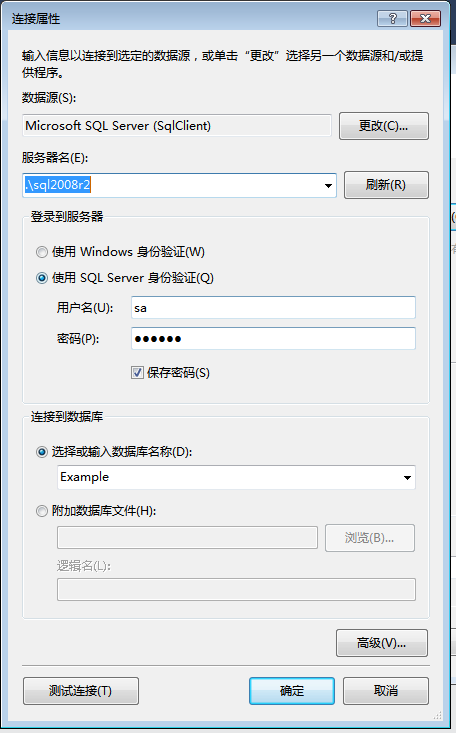
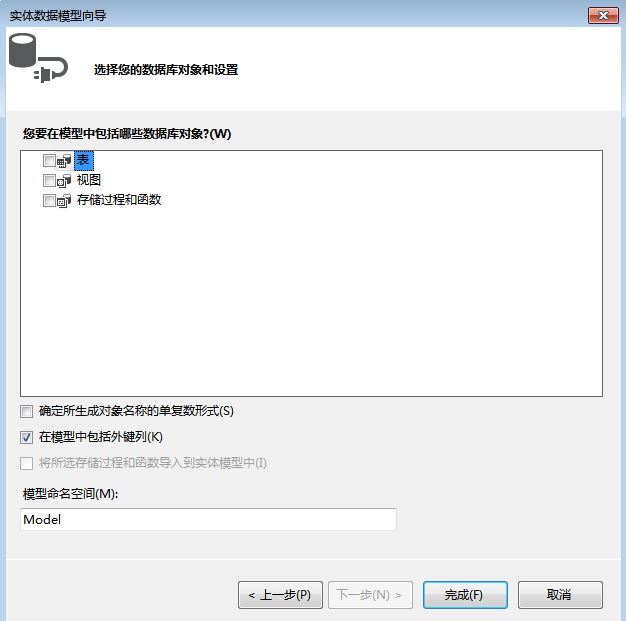
至此,Model数据层算了完成了。
DAL数据访问层创建
由于我们事件知道有几层,所以,先把所有的类库项目全部先建立好,web为MVC的空项目,至于各层代码,分到各层再去处理 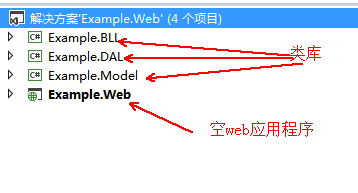
由于使用EF,为了方便使用EF扩展,先用nuget添加一个扩展包
EntityFrameWork.Extended,版本使用默认的就行。
添加好之后,就可以添加一个BaseDAL的类了,是为了方便DAL层操作的。
BaseDAL.cs
using System;
using System.Collections.Generic;
using System.Data.Entity;
using System.Linq;
using System.Linq.Expressions;
using System.Text;
using System.Threading.Tasks;
using EntityFramework.Extensions;
using Example.Model;
namespace Example.DAL
{
public class BaseDAL<T> where T : class
{
private ExampleEntities _db = null;
public ExampleEntities db
{
get
{
if (_db == null) _db = new ExampleEntities();
return _db;
}
}
public virtual IQueryable<T> Entities
{
get { return db.Set<T>().AsNoTracking(); }
}
public virtual IQueryable<T> Table
{
get { return db.Set<T>(); }
}
public IList<T> GetAll(Expression<Func<T, bool>> exp)
{
var query = db.Set<T>().Where(exp).AsNoTracking();
IList<T> data = query.ToList();
return data;
}
public int Add(T model)
{
try
{
EntityState state = db.Entry(model).State;
if (state == EntityState.Detached)
{
db.Entry(model).State = EntityState.Added;
}
//db.Set<T>().Add(model);
return db.SaveChanges();
}
catch (System.Data.Entity.Validation.DbEntityValidationException ex)
{
string errmsg = "";
foreach (var item in ex.EntityValidationErrors.First().ValidationErrors)
{
errmsg += item.ErrorMessage + " ; ";
}
throw new Exception(errmsg);
}
finally
{
}
}
/// <summary>
/// 批量添加
/// </summary>
/// <param name="models"></param>
/// <returns></returns>
public int AddCollect(List<T> models)
{
try
{
foreach (T model in models)
{
EntityState state = db.Entry(model).State;
if (state == EntityState.Detached)
{
db.Entry(model).State = EntityState.Added;
}
}
//db.Set<T>().Add(model);
return db.SaveChanges();
}
catch (System.Data.Entity.Validation.DbEntityValidationException ex)
{
string errmsg = "";
foreach (var item in ex.EntityValidationErrors.First().ValidationErrors)
{
errmsg += item.ErrorMessage + " ; ";
}
throw new Exception(errmsg);
}
finally
{
}
}
public int Edit(T model)
{
try
{
try
{
db.Set<T>().Attach(model);
}
catch { }
db.Entry(model).State = EntityState.Modified;
return db.SaveChanges();
}
catch (System.Data.Entity.Validation.DbEntityValidationException ex)
{
string errmsg = "";
foreach (var item in ex.EntityValidationErrors.First().ValidationErrors)
{
errmsg += item.ErrorMessage + " ; ";
}
throw new Exception(errmsg);
}
finally
{
}
}
/// <summary>
/// 批量修改
/// </summary>
/// <param name="models"></param>
/// <returns></returns>
public int EditCollect(List<T> models)
{
try
{
foreach (T model in models)
{
try
{
EntityState state = db.Entry(model).State;
db.Set<T>().Attach(model);
}
catch { }
db.Entry(model).State = EntityState.Modified;
}
return db.SaveChanges();
}
catch (System.Data.Entity.Validation.DbEntityValidationException ex)
{
string errmsg = "";
foreach (var item in ex.EntityValidationErrors.First().ValidationErrors)
{
errmsg += item.ErrorMessage + " ; ";
}
throw new Exception(errmsg);
}
finally
{
}
}
/// <summary>
/// 修改操作,可以只更新部分列,效率高
/// </summary>
/// <param name="funWhere">查询条件-谓语表达式</param>
/// <param name="funUpdate">实体-谓语表达式</param>
/// <returns>操作影响的行数</returns>
public virtual int Edit(Expression<Func<T, bool>> funWhere, Expression<Func<T, T>> funUpdate)
{
return Entities.Where(funWhere).Update(funUpdate);
}
public int Delete(T model)
{
try
{
db.Configuration.AutoDetectChangesEnabled = false;
db.Entry(model).State = EntityState.Deleted;
db.Configuration.AutoDetectChangesEnabled = true;
return db.SaveChanges();
}
catch (System.Data.Entity.Validation.DbEntityValidationException ex)
{
string errmsg = "";
foreach (var item in ex.EntityValidationErrors.First().ValidationErrors)
{
errmsg += item.ErrorMessage + " ; ";
}
throw new Exception(errmsg);
}
finally
{
}
}
public int DeleteExp(Expression<Func<T, bool>> exp)
{
try
{
var q = db.Set<T>().Where(exp);
db.Configuration.AutoDetectChangesEnabled = false;
db.Set<T>().RemoveRange(q);
db.Configuration.AutoDetectChangesEnabled = true;
return db.SaveChanges();
}
catch (System.Data.Entity.Validation.DbEntityValidationException ex)
{
string errmsg = "";
foreach (var item in ex.EntityValidationErrors.First().ValidationErrors)
{
errmsg += item.ErrorMessage + " ; ";
}
throw new Exception(errmsg);
}
finally
{
}
}
}
}
- 1
- 2
- 3
- 4
- 5
- 6
- 7
- 8
- 9
- 10
- 11
- 12
- 13
- 14
- 15
- 16
- 17
- 18
- 19
- 20
- 21
- 22
- 23
- 24
- 25
- 26
- 27
- 28
- 29
- 30
- 31
- 32
- 33
- 34
- 35
- 36
- 37
- 38
- 39
- 40
- 41
- 42
- 43
- 44
- 45
- 46
- 47
- 48
- 49
- 50
- 51
- 52
- 53
- 54
- 55
- 56
- 57
- 58
- 59
- 60
- 61
- 62
- 63
- 64
- 65
- 66
- 67
- 68
- 69
- 70
- 71
- 72
- 73
- 74
- 75
- 76
- 77
- 78
- 79
- 80
- 81
- 82
- 83
- 84
- 85
- 86
- 87
- 88
- 89
- 90
- 91
- 92
- 93
- 94
- 95
- 96
- 97
- 98
- 99
- 100
- 101
- 102
- 103
- 104
- 105
- 106
- 107
- 108
- 109
- 110
- 111
- 112
- 113
- 114
- 115
- 116
- 117
- 118
- 119
- 120
- 121
- 122
- 123
- 124
- 125
- 126
- 127
- 128
- 129
- 130
- 131
- 132
- 133
- 134
- 135
- 136
- 137
- 138
- 139
- 140
- 141
- 142
- 143
- 144
- 145
- 146
- 147
- 148
- 149
- 150
- 151
- 152
- 153
- 154
- 155
- 156
- 157
- 158
- 159
- 160
- 161
- 162
- 163
- 164
- 165
- 166
- 167
- 168
- 169
- 170
- 171
- 172
- 173
- 174
- 175
- 176
- 177
- 178
- 179
- 180
- 181
- 182
- 183
- 184
- 185
- 186
- 187
- 188
- 189
- 190
- 191
- 192
- 193
- 194
- 195
- 196
- 197
- 198
- 199
- 200
- 201
- 202
- 203
- 204
- 205
- 206
- 207
- 208
- 209
- 210
- 211
- 212
- 213
- 214
- 215
- 216
- 217
- 218
- 219
- 220
- 221
- 1
- 2
- 3
- 4
- 5
- 6
- 7
- 8
- 9
- 10
- 11
- 12
- 13
- 14
- 15
- 16
- 17
- 18
- 19
- 20
- 21
- 22
- 23
- 24
- 25
- 26
- 27
- 28
- 29
- 30
- 31
- 32
- 33
- 34
- 35
- 36
- 37
- 38
- 39
- 40
- 41
- 42
- 43
- 44
- 45
- 46
- 47
- 48
- 49
- 50
- 51
- 52
- 53
- 54
- 55
- 56
- 57
- 58
- 59
- 60
- 61
- 62
- 63
- 64
- 65
- 66
- 67
- 68
- 69
- 70
- 71
- 72
- 73
- 74
- 75
- 76
- 77
- 78
- 79
- 80
- 81
- 82
- 83
- 84
- 85
- 86
- 87
- 88
- 89
- 90
- 91
- 92
- 93
- 94
- 95
- 96
- 97
- 98
- 99
- 100
- 101
- 102
- 103
- 104
- 105
- 106
- 107
- 108
- 109
- 110
- 111
- 112
- 113
- 114
- 115
- 116
- 117
- 118
- 119
- 120
- 121
- 122
- 123
- 124
- 125
- 126
- 127
- 128
- 129
- 130
- 131
- 132
- 133
- 134
- 135
- 136
- 137
- 138
- 139
- 140
- 141
- 142
- 143
- 144
- 145
- 146
- 147
- 148
- 149
- 150
- 151
- 152
- 153
- 154
- 155
- 156
- 157
- 158
- 159
- 160
- 161
- 162
- 163
- 164
- 165
- 166
- 167
- 168
- 169
- 170
- 171
- 172
- 173
- 174
- 175
- 176
- 177
- 178
- 179
- 180
- 181
- 182
- 183
- 184
- 185
- 186
- 187
- 188
- 189
- 190
- 191
- 192
- 193
- 194
- 195
- 196
- 197
- 198
- 199
- 200
- 201
- 202
- 203
- 204
- 205
- 206
- 207
- 208
- 209
- 210
- 211
- 212
- 213
- 214
- 215
- 216
- 217
- 218
- 219
- 220
- 221
有了BaseDAL这个类,我们就来建立具体针对表的 SysUserDAL.cs
SysUserDAL.cs
很简单,我们就写个方法读取数据库中之前添加的一条测试数据
using System;
using System.Collections.Generic;
using System.Linq;
using System.Text;
using System.Threading.Tasks;
using System.Data.Entity;
namespace Example.DAL
{
public class SysUserDAL : BaseDAL<SysUser>
{
public SysUser GetUserById(int id)
{
return Entities.Where(o => o.Id == id).FirstOrDefault();
}
}
}
- 1
- 2
- 3
- 4
- 5
- 6
- 7
- 8
- 9
- 10
- 11
- 12
- 13
- 14
- 15
- 16
- 17
- 18
- 1
- 2
- 3
- 4
- 5
- 6
- 7
- 8
- 9
- 10
- 11
- 12
- 13
- 14
- 15
- 16
- 17
- 18
BLL逻辑处理层创建
在Example.BLL 项目中,添加 Example.BLL.cs
Example.BLL.cs
using Example.DAL;
using Example.Model;
using System;
using System.Collections.Generic;
using System.Linq;
using System.Text;
using System.Threading.Tasks;
namespace Example.BLL
{
public class SysUserBLL
{
private SysUserDAL _dal = null;
public SysUserDAL dal
{
get
{
if (_dal == null) _dal = new SysUserDAL();
return _dal;
}
}
public SysUser GetUserById(int id)
{
return dal.GetUserById(id);
}
}
}
- 1
- 2
- 3
- 4
- 5
- 6
- 7
- 8
- 9
- 10
- 11
- 12
- 13
- 14
- 15
- 16
- 17
- 18
- 19
- 20
- 21
- 22
- 23
- 24
- 25
- 26
- 27
- 1
- 2
- 3
- 4
- 5
- 6
- 7
- 8
- 9
- 10
- 11
- 12
- 13
- 14
- 15
- 16
- 17
- 18
- 19
- 20
- 21
- 22
- 23
- 24
- 25
- 26
- 27
BLL层内容也就完成了
BLL层就这么简单,如果不做数据方面的判断,直接调用DAL层的方法就行
MVC Web 表示层处理
先简单修改一下默认路由
创建首页控制器和页面Razor视图
Index控制器中修改action为Index的方法
private SysUserBLL _BLL = null;
public SysUserBLL BLL
{
get
{
if (_BLL == null) _BLL = new SysUserBLL();
return _BLL;
}
}
//
// GET: /Index/
public ActionResult Index()
{
ViewBag.FirstUser = BLL.GetUserById(1);
return View();
}- 1
- 2
- 3
- 4
- 5
- 6
- 7
- 8
- 9
- 10
- 11
- 12
- 13
- 14
- 15
- 16
- 1
- 2
- 3
- 4
- 5
- 6
- 7
- 8
- 9
- 10
- 11
- 12
- 13
- 14
- 15
- 16
Index.cshtml页面显示的修改
@{
Layout = null;
var model = ViewBag.FirstUser as Example.Model.SysUser;
}
<!DOCTYPE html>
<html>
<head>
<meta name="viewport" content="width=device-width" />
<title></title>
</head>
<body>
<div>
姓名:@(model!=null?model.UserName:"空")
</div>
</body>
</html>
- 1
- 2
- 3
- 4
- 5
- 6
- 7
- 8
- 9
- 10
- 11
- 12
- 13
- 14
- 15
- 16
- 17
- 18
- 19
- 1
- 2
- 3
- 4
- 5
- 6
- 7
- 8
- 9
- 10
- 11
- 12
- 13
- 14
- 15
- 16
- 17
- 18
- 19
运行效果:
此文章一步一步介绍如果搭建简单三层 ef mvc框架项目,关键流程和代码都已贴上,按步骤来应该可以正常运行,如果不能正常运行,可以同我交流,可以加补一些更详细的步骤。
后续会加上另外几种框架。
版权声明:
作者:真爱无限
出处:http://blog.csdn.net/pukuimin1226/
本文为博主原创文章版权归作者所有,欢迎转载,但未经作者同意必须保留此段声明,且在文章页面明显位置给出原文链接.
